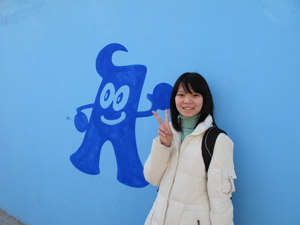
It seems to matter not whether you arrive at Shanghai's Pudong airport at sunset, or depart at sunrise. At either end of the day, and for most of the time in between, you can barely see anything, thanks to the pall of pollution that clings to the city and its, um, environs.
China, pollution, ho hum. Not exactly breaking news.
Yet Shanghai is billed in some quarters as the city of the future. It is preparing to hold a World's Fair, or Expo, whose theme is Better City, Better Life. An underlying motif of the Shanghai World Exposition is sustainability in the built environment. Somewhere in the enveloping haze, apparently, is a brave new world of urban green.
If the memory of the Beijing Olympics is of an absolutely audacious and breathtaking display of China's organizational prowess, the Shanghai Expo, barely two years on, promises to eclipse even the 2008 Olympics in size and ambition -- and its organizers hope to use it as a springboard for promoting environmental technologies in the Chinese construction industry at what can only be described as a moment that cannot come soon enough.
None of this is immediately evident driving towards the city over the flatlands of Pudong in fading light, on an elevated freeway where the Chinese, who have taken to the car with ardent but fairly recent affection, drive cautiously into the gloom.
The road to Expo
The freeway itself is brightly lit, isolated like a golf driving range in the middle of dark fields. It is fenced on either side, and sometimes in the middle, with high green barriers that, oddly, have windows installed at a height that ensures you cannot see anything through them. When, randomly, the barriers end and you can see over the freeway railing, well again, you can't see much because of a combination of the pollution's haze and that fact that apparently one way to ensure energy conservation in towering buildings and, indeed, whole neighborhoods is to simply not turn on any lights.
The impression is a cross between Margaret Atwood's The Year of the Flood and Cormac McCarthy's The Road, all darkness and dystopia, but then the eye is forced back to the real road ahead as the green barriers close back around you. The chauffeured car moves surreally slowly, given that the freeway is relatively uncluttered with traffic. There is a languid, cinematic quality to the journey, and you don't have to be William S. Burroughs to surrender to a sense that you're being propelled through a very long green plastic soda bottle.
And then, suddenly, the cap comes off. Suddenly there are lights. The Expo site on the Huangpu River is lit up, gaudily, like the inside of a casino. Suddenly, there are cars, 1.6 million of them down at street level, all of them apparently trying to turn left at an intersection just ahead of us. The undersides of the freeway are lit in purplish neon, painting the traffic jam in a putrid fluorescence. And in every direction, even at night, there is construction; a mad cycle of demolition and building that is a piece of fully 50 per cent of all construction worldwide that will take place in this country in the next five years.
That's right, the World Bank reportedly estimates that from now till 2015 "half of the world’s new building construction will take place in China," according to an article in the China Economic Review.
Going up
Shanghai sure seems to have the jump on the rest of the world. From the Park Hyatt's 91st floor restaurant, you can see down to the Bund district on the river, the scene of a massive waterfront makeover that its boosters say will produce a street comparable to the Avenue des Champs-Élysées. The roadway along the riverfront is being interred, so vehicle traffic will flow below foot traffic on a new retail promenade.
In time for Expo's opening in May, according to China Daily, almost 100 one-way streets will be created in downtown Shanghai and near the Expo site, in an effort to keep traffic moving while a projected 70 million people visit the World's Fair -- 90 per cent of them arriving by various forms of public transit. Half the visitors will travel by metro, on what will be the largest underground rail system in the world by the time the dust settles.
That puts Vancouver's Canada Line, arguably the one significant infrastructure legacy of our coming Olympics, in a somewhat diminished perspective.
There is plenty of civic boosterism associated with this Expo, as one might expect. Almost every available inch of hoardings and advertising space is painted with an irritatingly gleeful, bright blue mascot called Haiboa. It looks like a McDonald's toy, or more to the point, thousands of McDonald's toys that have thrown off their chains and are running rampant through the city -- waving, smiling, and inviting.
One stated goal of the Shanghai World's Fair is to break the world record for attendance at an international Exposition set by the 1970 Expo in Osaka, Japan, which topped 64 million visitors (Vancouver’s Expo ‘86, by contrast, attracted 2.2 million punters).
But attendance aside, what of the theme: Better City, Better Life?
Define 'better'
Ninety-one floors down from the Park Hyatt's vertiginous redoubt, it's hard to reconcile the profusion of office towers, hotels, and apartment buildings with the lane houses where many Shanghaiese still live in picturesque poverty.
On a couple of excursions through the lane houses and markets of what is left of old Shanghai, a pair of ex-pat businessmen lament the loss of whole neighborhoods to gleaming glass towers (full disclosure: one of the businessmen is my brother, an industrial designer and sometime property developer).
Expert at finding old buildings and modernizing them at their existing scale, they fear that central Shanghai is fast losing what little "village" flavour remains to office and residential towers and global brands. In the maze of lanes, meanwhile, drying underwear competes with sausage meat and eviscerated chickens for space to hang on overhead lines. Since it's hard to hang meat or panties off the side of a 100-storey glass and steel clad building, folks in these neighborhoods -- who will never live in any of the apartments being built on top of them because they are priced way out of reach --– will need to take their vitals and their vittles someplace else.
Better City, Better Life? The China pavilion at Expo, four crimson towers supporting a huge roof that looks a cross between a pagoda and an upside-down cheese grater, is being celebrated for a rainwater collection, purification, recycling and misting system that cuts the demand for air-conditioning. Plus, low-emission glass doors and windows deflect interior heat and convert it to electricity for lighting.
In the Israeli pavilion, meanwhile, expect to see breakthrough hybrid solar technology at the Expo. The Swedes have steel sheets that will save energy, and a concrete block product that is five times lighter than regular concrete and takes five times less raw material to produce. And so on.
But will any of this matter a tinker's damn to the people of Shanghai, already so numerous that the city's population exceeds that of the entire country of Australia? It's hard to say. It's even harder to see. ![]()
Read more: Travel, Urban Planning + Architecture















Tyee Commenting Guidelines
Comments that violate guidelines risk being deleted, and violations may result in a temporary or permanent user ban. Maintain the spirit of good conversation to stay in the discussion.
*Please note The Tyee is not a forum for spreading misinformation about COVID-19, denying its existence or minimizing its risk to public health.
Do:
Do not: